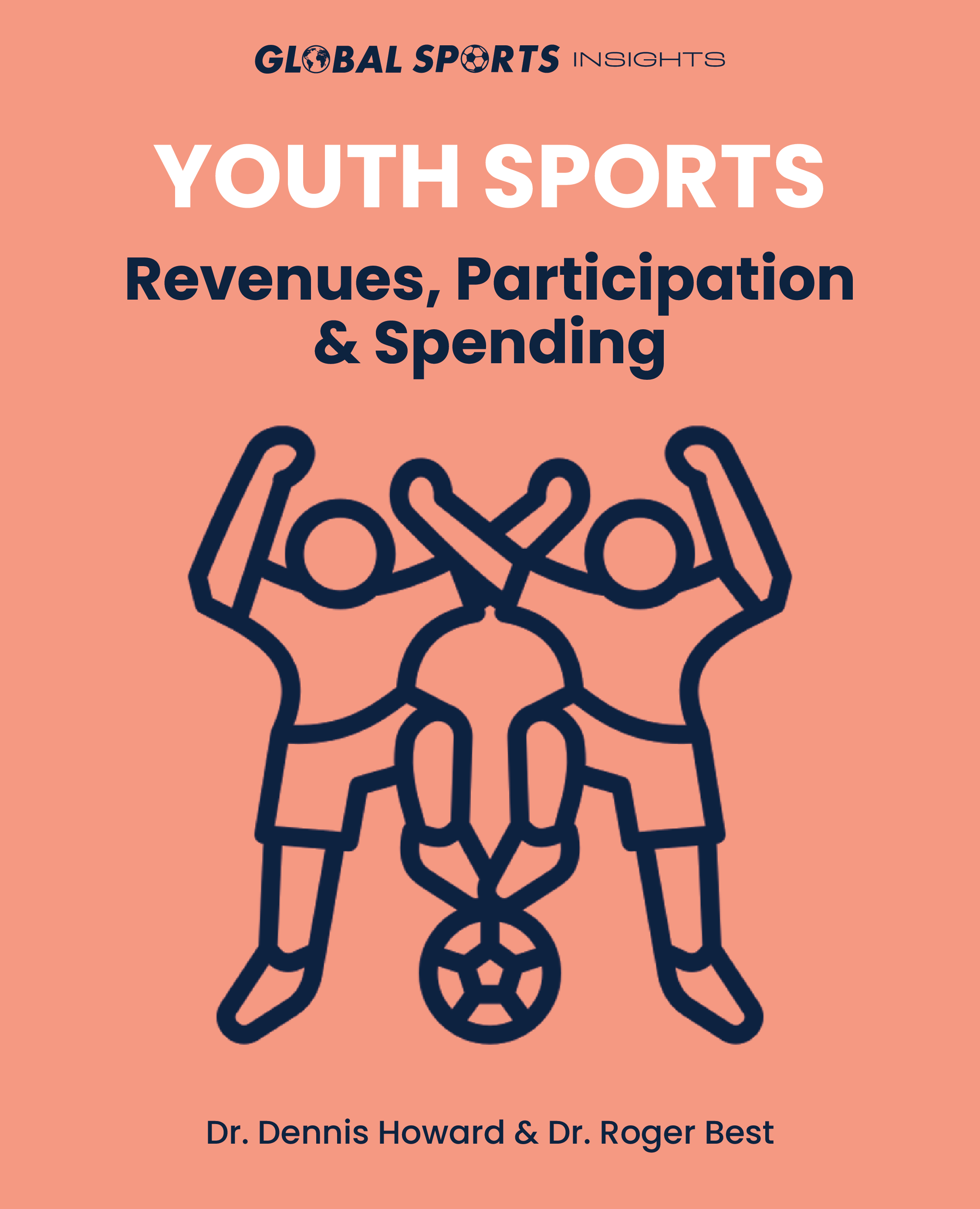Preview table of contents and sample page

About This Report
Over the past year, sports industry professionals and academic instructors have requested specific chapters from our book, The Business of Sports. The 450 page, 12 chapter book is available online ($79.50) and in print ($99.50) at www.globalsportsinsights.com. In response to those interested in selected topics, we are now offering a very reasonably priced menu of more focused content (e.g., How Big is the Sports Industry? Sports Events, Sports Entertainment, Sports Betting).
Below is a brief summary of the essential content of our Sports Industry Report on Youth Sports. The report is the result of an intensive search of the most current and credible data sources on this topic. In 2023, global spending on youth sports reached a record $64.3 billion. Youth sports in the U.S. accounted for the lion’s share, topping $43 billion. The report chronicles annual revenues generated from two principal sources: organized youth sports leagues and sports camps/academies from 2018 through 2023. The analysis examines the impact of the COVID-19 on youth participation and spending and the industry’s rate of recovery through 2023.
Woven into the analysis are videos that highlight the many benefits of youth engagement in sport, as well as the devastating reality that millions of children are inhibited from playing their favorite sport due to the growing cost of participation.
The final section, “The Global Perspective,” examines the many robust sports youth programs across the globe, highlighting data from those nations with “World’s Leading Sports Systems” from a 2023 Aspen Institute study. The report concludes with a comparative analysis of the historical and cultural factors influencing the many differences between the organization and delivery of youth sports between the United States and several European nations.
For instructors planning to use this report as a required reading, we provide extensive Instructor Support materials, including: Slides of key report graphics, Discussion Questions, and a Test Bank including multiple choice, short answer and essay questions.
We hope you find our report of great value and thank you for your purchase.
Dennis and Roger

Sports Industry Report
Contents
CONTENTS
Sample Page 1

Amazing Benefits of Youth Sports
Before diving into the financial magnitude and cost of youth sports, let’s take a short look at the many benefits of organized sports for children. As highlighted in the video below, these benefits directly boost fitness, build character (self-esteem, discipline, interpersonal skills), and “grit” values (perseverance, coping with failure). Research finds that sports participation also enhances classroom performance by improving how kids study and behave in school. Finally, sports expose and prepare youth for many of the realities of life by instilling values such as teamwork, collaboration and learning to take direction from peers and superiors.
5 Key Benefits of Sports for Kids
Copyright 2024 The Business of Sports
1
Sample Page 5
Youth Sports
Sports Industry Report
FIGURE 3
Sports Participation Rates by Age Cohort from 6 to 17 years

While a greater percentage of youth ages 13 to 17 were playing on a sports team over all four years than those 6 to 12, the participation level of the older teen cohort declined at a higher rate of 7%, falling from 41.7% in 2019 to 39.7% in 2022. The Aspen report attributes the greater loss to the fewer opportunities offered high school teens to play team sports after they have been cut from their school teams (7).
While core participation levels in team sports declined at all youth age levels from 2019 to 2022, on a more positive note the Aspen report found that more children ages 6 to 12 were playing a sport than before the pandemic. Total participation of elementary age kids playing sports at least once per year reached a decade high of 63% in 2022. A youth sports survey of parents revealed that fewer children are expressing that they have “lost interest” in playing sports. The 2022 survey found kids 6-10 and 15 to 18 years of age are nearly 3% less likely to
express an intent to quit sports than in the previous two years (8).
Closing the Gender Gap
A positive trend in youth participation is that more young girls are playing team sports than ever before (7). While the number of boys 6 to 17 competing in team sports has dropped from half to 40% over the last decade, girls’ team participation has increased (6). As shown in Figure 4, from 2019 to 2022, core participation by girls grew from 33% to 34.5%, while boys declined from 41.2% to 40.2% from 2019 to 2022. Over the 4-year period, girls closed the gender gap from 8.2% in 2019 to 5.7% in 2022.
Copyright 2025 The Business of Sports
5
Sample Page 13
Youth Sports
Sports Industry Report
It is evident from the current limited level of federal and state financial support for youth sports that there is a long ways to go before it will have a significant impact on affording low-income youth opportunities for full participation in sport. In the meantime, rising costs, prevent many low-income children from being able to participate. Click on the video below (Figure 8), “The Price of Youth Sports,” for a highly informative account of the growing gap between “Have” and “Have-Not” children’s access to sports and the devastating consequences.
FIGURE 8
The Price of Youth Sports
(NOTE: The $42.6 billion revenue estimate for youth sports spending in 2023 fully encompasses all aspects of youth sports activity)
Global Perspective
As shown in Figure 1, the U.S. has the largest sports market in the world but many countries have strong sports cultures with robust youth sports programs. Australia was recently recognized for having the highest rate of sports participation of any country, with 84% of Australians engaging in a sport at least once a month (14). Scandinavian countries, led by Norway and Sweden, are widely considered to deliver the world’s best grassroots and elite sports development programs for adults and youth.
The Aspen Institute’s 2023 report on the “World’s Leading Sport Systems” ranked Norway the highest of any nation, the only country to receive A- grades for Youth Sports Participation and Government Support, and the #1 Elite Sports Rank Per Capita (15). Other nations receiving high marks for youth sports participation were Sweden and Spain. Readers interested in learning more about the governing structures of the sports ecosystem and youth participation in the U.S. and 11 peer nations are encouraged to explore the Aspen Institute report.
Copyright 2025 The Business of Sports
13
